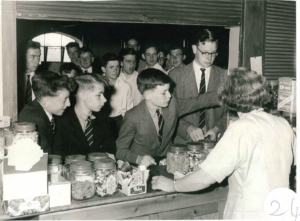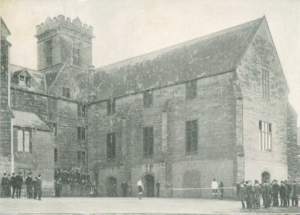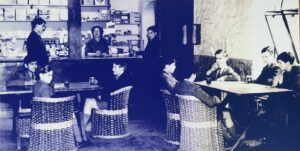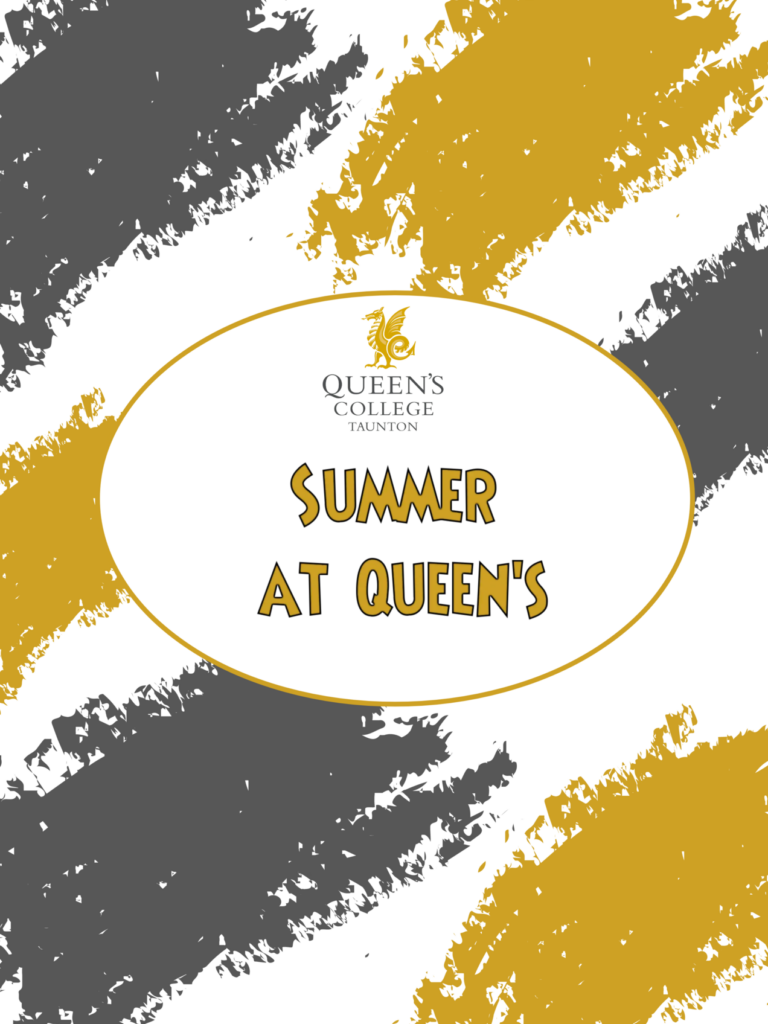Schools that play Fives use one or other of the versions played at Rugby or Eton. Few are aware that there was a third variation of the rules which was only played at Queen’s College. The distinctive features of the latter were threefold. Firstly, the ball could be kicked as well as hit with the hand in contrast to the other two games which did not allow the ball to be kicked. Secondly, at Queen’s the ball was played against a wall with two side buttresses, one at right angles and the other at 45 degrees to the front wall. In addition, the ball used in the Rugby and Eton games was hard and padded gloves were needed whereas a soft ball was used at Queen’s and no glove was allowed.
Until 1911, the game was played against the wall of the Covers between the buttress to the right of the doorway and the one at the corner. The photo of a house match in 1906 shows boys playing Fives with a white horizontal line between the buttresses clearly defining the level above which the ball had to be hit at a certain point in a match. It was in 1848, just a year after the school had moved to its present site, that it was decided to cover the window between the buttresses with wire gauze so the game could be played there.
The photo is also instructive in showing the popularity of the sport with spectators standing on the periphery of the playing area and others perched on top of the porch leading to the belfry stairs. In fact, virtually every boy in the school played the game. This is confirmed by the draw for the annual singles competition which took place every spring term and which was meticulously recorded in the Wyvern. In the early 20th Century there were 64 players in the first round of the senior competition and often many more in the preliminary round so the player who emerged as the champion would have won a minimum of six matches. The event for juniors was equally popular. Approximately half the boys in the school played in one or other of these competitions.
The rules of Queen’s Fives were complicated and there were differences between singles and doubles. In the latter, after a team had scored a sixth point a game ball was played and at this stage of the match the team with the game ball was reduced to one player. A skilful player of game-ball could hold his two opponents for long periods. Apparently, in 1903 the South v North match was played over two afternoons. The game-ball was abolished in 1907. It was never part of the singles game. A singles consisted of ten points: ‘in’ and ‘one to nine’. Both singles and doubles were the best of three sets.
Indeed, such was the enthusiasm for the game that a second court was erected in 1911. This was intended to relieve the pressure on the wall outside the Covers as well as providing a smoother surface against which to hit the ball. Details about this court are provided on another part of the heritage trail – go to the Sixth Form block. Only 12 years later a new Fives wall was erected. Details about this court are explained elsewhere on the heritage trail – go to the Physics Laboratories.
The Covers themselves have had various uses over the years. When the building was first constructed it was one large space with three brick pillars down the centre providing support for the dining hall above. What the room was used for initially is not clear but it may have been for storage. At some point, and probably by the early 20th Century, it was a games room, containing a ¾ length billiard table and two table tennis tables. From about 1951 these facilities were located elsewhere and the space was partitioned to make room for the tuck shop accessed through the side door shown in picture 1, leaving the room on the other side as a dayroom which musicians also used for ‘jam’ sessions. The tuck shop was run by Mrs Fagg. She is shown behind the counter, which was directly opposite the side door taken in c.1952 when pupils had the luxury of wicker chairs and tables. Another picture gives the view of Mrs Fagg serving her customers during break time in the 1960s. The crush for sweets was such that there was always a prefect on duty at opening times to keep order.
Mrs Fagg started at Queen’s in 1942 as a part-time secretary to the Headmaster and combined this task with running the tuck shop from 1951. When, shortly after that a school shop for clothing was established in a space next to the tuck shop, Mrs Fagg gave up her role as secretary and took on the responsibility for the clothes shop as well as the tuck shop. She continued to run the tuckshop until she retired in 1987 at which time the dayroom was being used as a classroom for Latin, entered by the door at the gable end. Then, for a few years the room was used as the IT hub in the days when the school first set up a computer network for the college.
A tuck shop was introduced in 1885 from which boys could buy not only sweets but caps, balls and other sports kit under the control of the Sports Committee with profits going to the Games Fund. Mrs Bond supervised the tuck shop until 1910 and did so from the School Lodge where she lived with her husband, William. Mrs Brown took over the tuck shop when she and her husband, John, replaced the Bonds in the lodge. Mary Wood took over from Mrs Bond and ran the tuck shop for many years.
Nowadays the Covers provide three useful classrooms and an office, created by rearranging the partitions.
Click on the image to expand:












